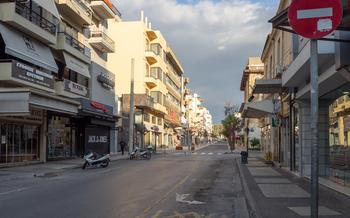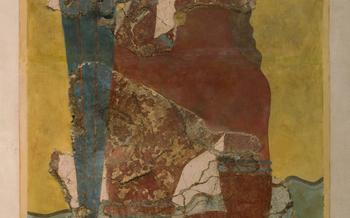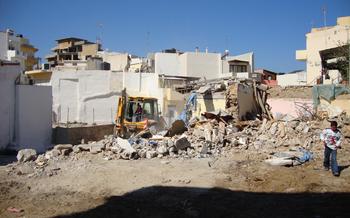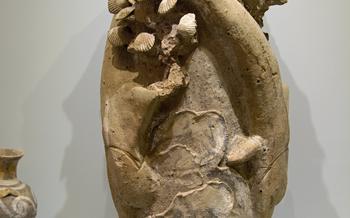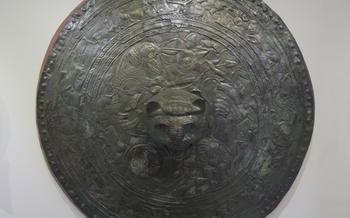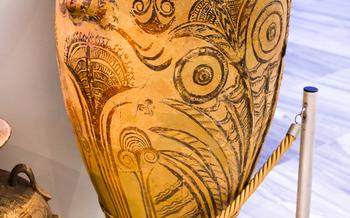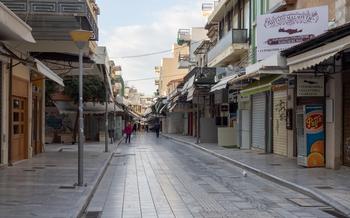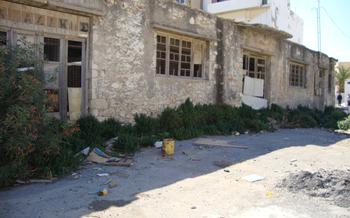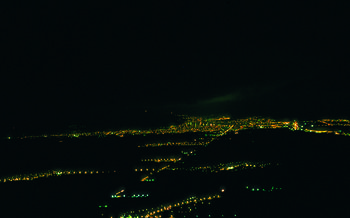
Kommos Archaeological Site
- Kommos Archaeological Site: Unveiling Minoan Civilization's Secrets
- Location and Accessibility: Finding Your Way to Kommos
- Guided Tours and Self-Exploration: Unveiling Kommos' Treasures
- What to Expect at Kommos: A Journey Through Time
- Kommos Beach: A Perfect Complement to Your Visit
- Minoan Art and Architecture: A Masterpiece of Ancient Craftsmanship
- The Harbor and Maritime Trade: A Gateway to the Mediterranean
- The Minoan Palace: Power and Administration
- Workshops and Storage Facilities: A Thriving Economic Center
- Religious and Ritual Practices: Connecting with the Divine
- Archaeological Excavations: Uncovering Kommos' Secrets
- Kommos Museum: A Treasure Trove of Minoan Artifacts
Kommos Archaeological Site: Unveiling Minoan Civilization's Secrets
The Kommos Archaeological Site is a treasure trove of Minoan history, silently nestled along the southern coast of Crete, approximately 62 kilometers southeast of Heraklion. This ancient port and settlement played a pivotal role in the maritime trade and cultural interactions of the Minoan civilization, flourishing during the Bronze Age between 2000 and 1450 BC.
Archaeological excavations at Kommos have unearthed a wealth of artifacts and structures, shedding light on the intricate workings of Minoan society. Among the most significant discoveries are the remains of a Minoan palace, workshops, storage facilities, and a harbor, offering a glimpse into the political, economic, and religious aspects of this fascinating civilization. Kommos stands out from other Minoan sites due to its well-preserved harbor, providing valuable insights into the maritime prowess of the Minoans, who traversed the Mediterranean Sea, establishing trade relations and cultural exchanges with distant lands.
Location and Accessibility: Finding Your Way to Kommos
Geographic Coordinates and Proximity to Major Cities: The Kommos Archaeological Site is located on the southern coast of Crete, approximately 65 kilometers southeast of Heraklion, the island's capital. Its exact geographic coordinates are 35°00'46"N 25°07'00"E. The site is conveniently situated near several major cities and towns in Crete, making it easily accessible for visitors.
Transportation Options: To reach Kommos, visitors can opt for various transportation options. Public buses provide a convenient and affordable means of travel, departing from Heraklion and other nearby cities. Taxis are also readily available, offering a more personalized and direct route to the site. For those who prefer the freedom and flexibility of self-guided exploration, rental cars are a popular choice.
Parking Availability: Ample parking space is available near the Kommos Archaeological Site, ensuring that visitors can conveniently park their vehicles. Parking fees are typically charged, with designated areas for both cars and buses. The parking area is well-maintained and provides easy access to the site's entrance.
Guided Tours and Self-Exploration: Unveiling Kommos' Treasures
Visitors to the Kommos Archaeological Site have the opportunity to explore this ancient Minoan settlement in two ways: through guided tours or self-guided exploration. Guided tours are available in various languages and offer a comprehensive overview of the site's history, architecture, and artifacts. These tours are led by experienced guides who provide insightful commentary and answer questions, allowing visitors to gain a deeper understanding of Kommos.
For those who prefer a more independent experience, self-guided exploration is also an excellent option. Visitors can wander through the site at their own pace, taking in the sights and sounds of this ancient city. Maps, guidebooks, and mobile apps are available to help visitors navigate the site and learn about its various features. This approach allows for a more personalized experience, as visitors can choose to focus on specific areas of interest and linger longer in places that capture their attention.
What to Expect at Kommos: A Journey Through Time
As you step into the archaeological site of Kommos, you will be transported back in time to the vibrant world of the Minoan civilization. The site is divided into several distinct areas, each offering a glimpse into the daily lives and rituals of this ancient culture.
The main highlight of Kommos is the impressive Minoan palace, a testament to the power and prosperity of this ancient city. The palace features grand staircases, elaborate rooms, and intricate wall paintings depicting scenes from Minoan life and mythology. It is believed to have been the administrative and political center of Kommos, where rulers held court and conducted official business.
In addition to the palace, Kommos is home to a number of workshops and storage facilities. These areas provide insights into the economic activities of the Minoan civilization. The workshops were used for pottery, metalworking, and stone carving, while the storage facilities were used to store agricultural products, such as wine and olive oil.
One of the most fascinating aspects of Kommos is the evidence of its role as a major port and trading hub. The harbor area features the remains of quays, jetties, and warehouses, indicating the bustling maritime trade that took place here. Artifacts found at the site, such as pottery, metals, and textiles, reveal the types of goods that were traded with other Mediterranean civilizations, including Egypt, Cyprus, and the Cyclades.
Throughout the site, you will find numerous artifacts that offer clues to the daily lives and rituals of the Minoan people. These include pottery, tools, religious objects, and even the remains of food and other organic materials. These artifacts provide a tangible connection to the past, allowing visitors to imagine the sights, sounds, and smells of this ancient city.
Kommos Beach: A Perfect Complement to Your Visit
Adjacent to the ancient ruins of Kommos lies a picturesque beach that beckons visitors to immerse themselves in its tranquil beauty. This secluded haven, characterized by its crystal-clear waters and soft golden sand, offers a refreshing respite from exploring the archaeological site. Bask in the warm embrace of the Mediterranean sun as you lounge on comfortable sunbeds, shielded from the elements by umbrellas. Quench your thirst and satisfy your appetite at one of the charming tavernas dotting the beach, savoring delicious local cuisine while enjoying panoramic views of the sparkling sea. For those seeking adventure, the crystal-clear waters invite you to snorkel and explore the vibrant underwater world, teeming with colorful marine life. Combine the allure of history with the allure of nature by visiting the Kommos Archaeological Site and then indulging in the serenity of Kommos Beach, creating an unforgettable experience that blends the wonders of the past with the pleasures of the present.
Minoan Art and Architecture: A Masterpiece of Ancient Craftsmanship
Kommos boasts a treasure trove of Minoan art and architecture, showcasing the creativity and craftsmanship of this ancient civilization. Exquisite frescoes and wall paintings adorn the walls of buildings, depicting vibrant scenes from Minoan life and mythology. These works of art offer a glimpse into the beliefs, values, and daily activities of the Minoans. The architectural features of Kommos are equally impressive, showcasing advanced construction techniques and a unique style. Grand staircases, elaborate rooms, and intricate doorways characterize the buildings, demonstrating the Minoans' mastery of architecture. Comparing Kommos' architectural style with other Minoan sites, such as Knossos and Phaistos, reveals both similarities and differences, highlighting the diversity of Minoan architecture. Kommos' unique features contribute to its significance in understanding the evolution of Minoan art and architecture and offer valuable insights into the artistic and cultural achievements of this remarkable civilization.
The Harbor and Maritime Trade: A Gateway to the Mediterranean
Kommos' strategic location on the southern coast of Crete made it a significant hub for maritime trade during the Minoan era. The sheltered harbor provided a safe haven for ships to dock and exchange goods with the Minoans. Archaeological evidence, such as storage facilities and shipwrecks, indicates that Kommos was involved in extensive trade with other Mediterranean civilizations, including Egypt, Cyprus, and the Cyclades.
Excavations at the site have uncovered a wealth of artifacts that shed light on the types of goods traded. These include pottery, metals, textiles, and agricultural products such as wine and olive oil. The presence of these items suggests that Kommos played a crucial role in facilitating cultural exchange and the spread of Minoan influence throughout the Mediterranean region.
The harbor at Kommos also served as a gateway for the Minoans to explore and interact with other cultures. Through trade and cultural exchange, the Minoans were able to acquire new ideas, technologies, and artistic influences, which contributed to the development of their own unique civilization. The maritime trade at Kommos was not only essential for economic prosperity but also played a vital role in shaping the cultural identity of the Minoan people.
The Minoan Palace: Power and Administration
The Minoan palace at Kommos stands as a testament to the power and administrative prowess of the Minoan civilization. Located at the heart of the settlement, the palace served as the center of political and economic activities. Its grand staircases, elaborate rooms, and impressive architecture reflect the importance and status of the rulers who resided within its walls.
The palace's strategic position overlooking the harbor further emphasizes its role as a center of power. From here, the rulers could oversee the bustling maritime trade and maintain control over the flow of goods and resources. The palace's proximity to the storage facilities and workshops also suggests its involvement in the economic management of the settlement.
Comparison of the Kommos palace with other Minoan palaces, such as Knossos and Malia, reveals similarities in architectural style and features. However, Kommos' unique location and its direct access to the sea set it apart from its counterparts. This strategic advantage allowed Kommos to play a significant role in maritime trade, facilitating cultural exchange, and spreading Minoan influence throughout the Mediterranean region.
Workshops and Storage Facilities: A Thriving Economic Center
Kommos was not only a major port but also a thriving economic center, as evidenced by the numerous workshops and storage facilities discovered at the site. These workshops provided tangible evidence of the Minoans' advanced craftsmanship and economic activities.
Among the workshops uncovered were those dedicated to pottery, metalworking, and stone carving. The pottery workshop, in particular, was quite extensive, with kilns, tools, and a large quantity of pottery fragments found on site. This suggests that pottery production was a significant industry in Kommos, with the finished products likely traded both locally and abroad.
In addition to the workshops, there were also several storage facilities at Kommos. These facilities were used to store agricultural products, such as wine and olive oil, as well as other goods that were traded or used by the local population. The presence of these storage facilities indicates that Kommos was a major center of production and trade in the region.
The workshops and storage facilities at Kommos provide valuable insights into the economic activities and production processes of the Minoan civilization. They demonstrate the Minoans' skill and expertise in various crafts, as well as their ability to organize and manage a complex economy.
Religious and Ritual Practices: Connecting with the Divine
Kommos, like other Minoan settlements, had a strong religious component that permeated daily life. Sacred spaces and shrines dedicated to various deities have been discovered within the site, providing insights into the religious beliefs and practices of the Minoans. Ritual objects, such as figurines, offering tables, and libation vessels, have been unearthed, shedding light on the rituals and ceremonies performed at Kommos.
One of the most significant religious structures at Kommos is the House of the Pillar Crypt, a building believed to have served as a religious center. The crypt features a large pillar in the center, possibly representing a divine presence, and benches along the walls where worshippers may have gathered for rituals.
The Minoans at Kommos worshipped a pantheon of deities, including the Great Goddess, the Mother Earth Goddess, and the Bull God. These deities were associated with fertility, agriculture, and the natural world, reflecting the close connection between the Minoans and their environment.
The religious practices at Kommos shared similarities with those of other Minoan sites, such as the veneration of certain deities and the use of similar ritual objects. However, there were also unique aspects to the religious life at Kommos, such as the emphasis on the Pillar Cult and the presence of specific shrines and offerings dedicated to specific deities.
Understanding the religious and ritual practices at Kommos provides a glimpse into the spiritual beliefs and values of the Minoan civilization. It reveals the importance of religion in Minoan society and its role in shaping the daily lives and cultural identity of the people who inhabited this ancient settlement.
Archaeological Excavations: Uncovering Kommos' Secrets
The history of archaeological excavations at Kommos dates back to the early 20th century when Italian archaeologists first explored the site. In the 1960s, American archaeologist Joseph Shaw began extensive excavations that uncovered significant portions of the Minoan settlement, including the palace, workshops, and harbor. These excavations shed light on the site's importance as a port and trading center, as well as its role in Minoan society.
Over the years, subsequent excavations by Greek and international teams have further contributed to our understanding of Kommos. These excavations have uncovered a wealth of artifacts, including pottery, tools, jewelry, and religious objects, providing valuable insights into the daily lives, economy, and religious practices of the Minoan people.
Ongoing research and excavations at the site continue to uncover new information and shed light on the complex history of Kommos. Archaeological work at Kommos is crucial for preserving and interpreting the site's rich history and its significance in understanding the Minoan civilization.
Kommos Museum: A Treasure Trove of Minoan Artifacts
After exploring the archaeological site, a visit to the Kommos Museum is a must to delve deeper into the treasures unearthed from this ancient Minoan settlement. Located a short distance from the site, the museum houses a remarkable collection of artifacts discovered during the excavations.
As you step inside, you'll be greeted by a diverse array of pottery, tools, jewelry, and other artifacts that showcase the artistry and craftsmanship of the Minoans. Each item tells a story about their daily lives, religious beliefs, and trading practices.
Interactive exhibits and educational displays provide context and information about the finds, allowing you to gain a deeper understanding of Minoan culture. Learn about the significance of the pottery designs, the techniques used to create the intricate jewelry, and the purpose of the various tools and implements.
Through these exhibits, the museum brings the ancient world of Kommos to life, offering a glimpse into the lives of its inhabitants and their contributions to the Minoan civilization. It's a must-visit destination for anyone interested in exploring the rich history and cultural heritage of this fascinating archaeological site.
